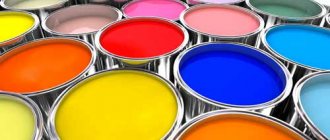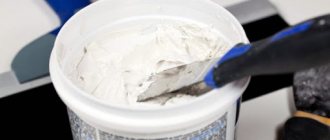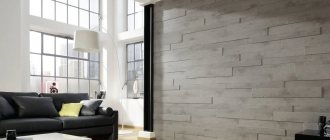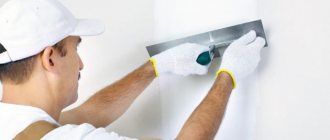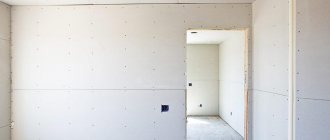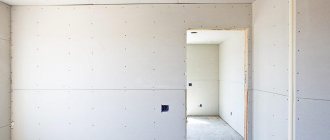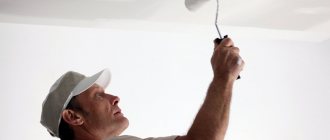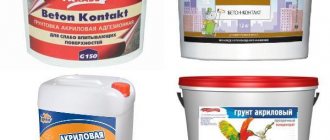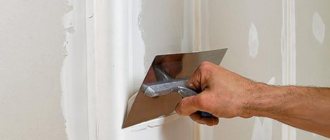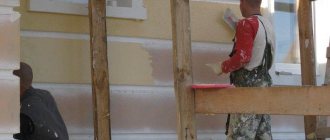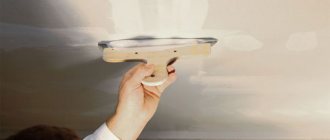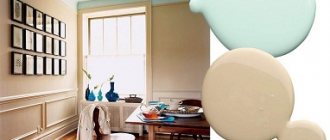Finishing ceilings and walls with plasterboard allows you to make the leveling process as simple as possible. But even such a smooth surface needs adjustment, which will significantly simplify subsequent finishing and decorative finishing. In this case, the question of which putty to choose for drywall becomes relevant, since the service life of the finishing coating and the aesthetics of the interior depend on the quality of the putty material.
Features of putty compositions for gypsum boards
Before finishing work, it is necessary to decide in advance which putty to putty on the drywall so that the finishing coating lies on it efficiently and evenly. The modern building materials market offers a wide selection of putties for leveling plasterboard surfaces, so finding the best option will not be difficult.
When finishing walls with sheets of plasterboard, joints, seams and cracks are formed, which represent a risk factor for the entire structure. Harmful microorganisms can spread in the recesses and cracks of gypsum boards, and mold appears, which leads to deformation and destruction of the finishing coating. Such consequences lead to significant costs for eliminating defects and repeated repair work, so at the planning stage it is very important to correctly understand which putty is best for drywall.
If complete puttying of drywall is not always advisable, then sealing the joints must be done
In some cases, sheets of drywall can be fitted as tightly as possible, and the joints are practically invisible. However, even in this case, you should not neglect putty, since drywall tends to move when exposed to moisture and temperature changes. Therefore, you should choose a putty for drywall that is characterized by high strength and elasticity. It is also necessary to pay attention to the drying time and environmental friendliness of the composition.
Selecting material according to purpose
Standard work on puttying plasterboard walls includes processing of joints, sheet fastening areas and corner junctions, as well as leveling treatment, which is designed to create a flat plane suitable for finishing. If you plan to cladding or wallpapering the walls, one layer of putty will be enough, but provided that the surface does not have significant flaws. The surface required for painting is as smooth as possible, so several layers of material will be required until the result is optimal.
Important! For each stage, it is necessary to select a putty with certain functional characteristics. Some are used to eliminate cracks and grout joints, others for leveling, and still others for decorative finishing of walls and ceilings.
Each type of drywall putty, intended for a specific stage, has its own characteristics.
| Type of putty | Purpose | Characteristics |
| Starting (leveling) | Treatment of seams, noticeable depressions, large cracks and other surface defects | Coarse-grained mixture, which is used exclusively for rough primary processing. Available in white, gray, brown and other colors |
| Finish | Applying the finishing layer, eliminating remaining imperfections and achieving the most even surface possible for painting or wallpapering | Fine white mixture |
| Universal | Has the functions of basic and finishing putty, can be used for sealing seams, eliminating defects, leveling walls and other putty work | Dry powder or ready-made mixture of white color, which is characterized by increased strength and good adhesion |
Drywall puttying technology
The quality of work with putty directly depends on following the manufacturer’s recommendations. Before applying the putty, prepare the surface appropriately.
It is cleaned, degreased, and primed (preferably in two layers). Adhesion and consumption of the composition depend on whether preliminary priming has been carried out. Alkyd primer cannot be used for drywall - it will deform the paper layer.
The primer is selected depending on the type of finishing. If drywall is planned under tiles or tiles, then an adhesive compound is used. If under the wallpaper, then deep penetration is better.
Applying putty
Before applying putty, make sure that all screws are screwed in correctly, and that there are no peelings of paper from the gypsum core at the joints of the sheets. If necessary, they are cleaned with a drywall knife and treated with sandpaper. If there is no edge on the sheets, then it is formed by cutting the edges with the same knife at an angle of 45 degrees.
After this, begin applying the putty:
- First the seams are closed. This is done using two spatulas - narrow and wide. First, a small amount of solution is applied to the second and applied to the surface. During the process, make sure that lumps and unevenness do not form, and that the solution is applied evenly, covering the entire seam. This will save you from unnecessary hassle with sanding. We must not forget about reinforcement with paper tape or sickle tape. Serpyanka is glued before applying mortar to the seam. The paper tape is pressed into the existing layer and covered with another layer on top.
- Then the holes from the screws are sealed. The composition is applied with a spatula crosswise - lengthwise and crosswise.
- After this, the corners are puttied. First, remove one side of the inner corner, and after the putty dries, the other. Aluminum corners are attached to the outer corners and coated with a solution on top.
- After the rough layer has dried, they move on to the finishing putty. This is best done with a wide spatula. Laying several thinner layers is allowed.
Sanding the putty
After drying, the surface is sanded until smooth. If any flaws remain, apply an additional layer. There is no need to putty the entire surface. Drywall itself is a flat and smooth material. Check whether additional putty is needed by applying a wide spatula or lath to the surface. If there are no gaps, the surface is flat.
The video shows how to putty correctly:
Readiness for use as a selection criterion
Drywall putty can be purchased ready-made or dry, each of which has its own advantages and disadvantages. The finished composition does not require preliminary preparation - you just need to stir it thoroughly, and then immediately start working. In contrast to the dry mixture, ready-made putty has a higher cost and a shorter shelf life when packaged. The finished putty can be used intermittently - it can be stored for a relatively long time in a tightly closed container without losing its properties. The dry mixture becomes unsuitable for puttying within half an hour after mixing, so the amount of material must be calculated in advance.
To putty drywall, you can use both dry mixtures and ready-made compounds
Powdered compositions, due to their low price, are widely popular in cases where it is necessary to putty a large area. Dry mixtures can be used in doses and stored anywhere, since temperature conditions do not affect their quality.
For inexperienced finishers, dry putties are not the best option, since they require preliminary mixing using a construction mixer or a drill with a special attachment, and it may also be difficult to determine the correct consistency.
Gypsum mixture is an ideal solution for drywall
Construction and repair specialists claim that for finishing plasterboard walls, a gypsum-based mixture is one of the most optimal options. This putty is made on the basis of natural material and fillers that improve performance characteristics.
Gypsum putty is the best option for puttying gypsum boards
Among the advantages of the gypsum mixture are the following characteristics:
- does not shrink when drying;
- adheres well to the surface of drywall;
- has high plasticity;
- easy to apply and level;
- dries quickly and adheres firmly.
To prepare the putty, you just need to add the required amount of water to the plaster in accordance with the manufacturer’s recommendations indicated on the packaging.
Important! The only drawback of gypsum is its low resistance to moisture, so in rooms with high humidity, preference should be given to other putty materials.
How to choose putty for drywall
Large hardware stores usually have a huge selection of everything - not only putty, but also other tools for repairs. Therefore, it is very easy to make a mistake and buy something that is not exactly what you need. How to choose the right putty? First you need to understand what it is.
Firstly, among the many types of putties, you will immediately understand that not all are suitable for your purposes. There are putties for ceilings and floors, there are those for covering up cracks and chips, and there are generally purely decorative ones that will not fulfill either the first or the second task 100%.
Secondly, based on the material contained in the putty base, gypsum, acrylic and cement mixtures are distinguished.
- Cement is used in rooms with high moisture content - bathrooms, toilets, and also outdoors. It is difficult to work with such material, since in a dried state they are difficult to mechanically influence. Sanding occurs almost immediately after application, without waiting for drying. But it is produced quite rarely, since the cement mixture is more convenient to use in cases where it will not be visible - for example, when laying tiles. The advantage of this putty is its strength.
- Gypsum is used in dry rooms. Prolonged exposure to moisture can destroy it. Gypsum putty looks more neat and is easier to work with when applying thin-layer decorative coatings.
- Polymer putty combines the best qualities of cement and gypsum putties, that is, it can be used in any room. It provides an ideal result, is easy to apply, does not consume much, but is very expensive. Polymer putties include acrylic and latex putties. Acrylics are used in both interior and exterior work. It is used only to bring the surface to an ideal state. Therefore, it is applied very thinly - about 1 mm. This putty is ideal for the final finishing of the ceiling, as it can make it mirror-like. Latex putty is easily applied in a layer of about 3 mm, perfect for plasterboard sheets. This putty should dry in a draft-free room.
Features of cement putty
Cement-based putty is a material with the highest water resistance; in addition, it can withstand temperature changes well, so it is suitable for finishing facades and for any type of room, including kitchens and bathrooms. Thanks to its properties, the material reliably protects the base from water and evaporation, reducing the risk of deformation and destruction of the structure. The advantage of cement putty is considered to be its high resistance to mechanical stress after drying, however, when working with this material you must be extremely careful, since correcting defects on a dried surface will be problematic. The disadvantage of this mixture is strong shrinkage during the drying process, as a result of which numerous cracks can appear in the finish, so puttying should be done several times. This type of putty is not used for decorative finishing in residential premises, but it is perfect for rough work in bathrooms and technical rooms.
It is advisable to use cement putty only for wet rooms
How to choose putty for drywall?
Drywall is an excellent building material that is used by many today. The products have a relatively low price, so they are available in any store. But, regardless of this, you should work with the material carefully, since it is fragile. To improve strength and decorative characteristics, drywall is often coated with putty. There are several types of such solutions, so it is important to take into account certain nuances of each of them when choosing mixtures.
Polymer putty is the key to a durable finish
The polymer mixture is considered the most convenient putty to use, which is used in various fields and has the following advantages:
- high moisture resistance;
- strength;
- no shrinkage when drying;
- convenient application.
The only drawback of this material is its relatively high cost, which leads to a significant increase in the cost of finishing work, especially in large premises.
Polymer putty provides the highest quality coating
Polymer-based putty is used with equal success for leveling plasterboard surfaces in any room, be it bathroom walls or kitchen ceilings. Polymer leveling compounds are most often used as finishing putty, as they effectively eliminate even the smallest imperfections, providing a perfectly smooth surface. The putty is applied in a thin layer of up to 1 mm, this will be enough to achieve an even plane and prepare the wall for further painting or wallpapering. High-quality finishing mixtures are easy to apply and stretch along the wall, providing economical consumption. Even non-professionals can easily handle this material, getting maximum results in interior design. In addition, by choosing a polymer product, you can forget about repeated repairs for a long time.
